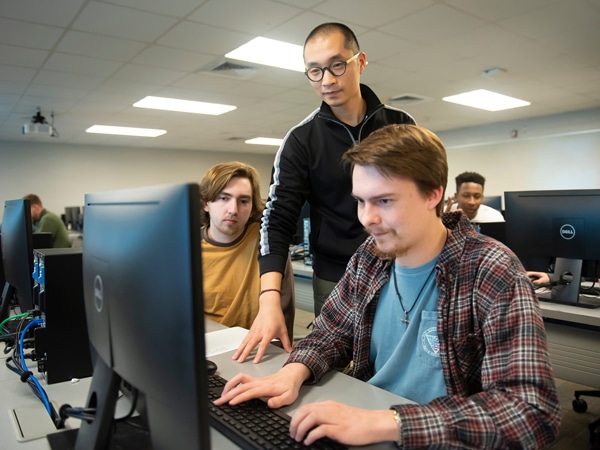AUM assistant professor earns NSF grant to develop solutions to prevent catastrophic power blackouts
AUM assistant professor earns NSF grant to develop solutions to prevent catastrophic power blackouts
Auburn University at Montgomery (AUM) recently earned a three-year, $105,281 grant by the National Science Foundation to develop new computational methods and tools to prevent catastrophic power network failures such as those that occurred throughout the northeastern U.S. and parts of Canada in 2003.
Tianran Chen, assistant professor of mathematics, will use the grant to study how these complex power networks operate and why some operate efficiently while others experience catastrophic failures. Robert Davis, an assistant professor of mathematics at Colgate University, and AUM undergraduate research student Evgeniia Korchevskaia, will collaborate with Chen on the project.
In today’s modern society, power networks are of fundamental importance to every aspect of modern day life — from plugging in a blow dryer to powering air conditioners to cool homes and businesses, said Chen, principal investigator of the project.
“Our focus will be to understand how these massive power networks acquire electricity and use it for generating and distributing electrical power,” he said. “The security of these networks is especially important because of how we depend on them in modern life. Every time you plug in your phone charger you are draining power from one of these massive power grids.”

By understanding how such power grids generate, transfer and consume electric energy, the team of researchers hopes to improve the efficiency, stability and resilience of power networks and provide mathematical analysis that could assist engineers with agencies such as the Department of Energy prevent future major power network outages.
“Electrical engineers spend a lot of time studying the design and operation of power grids,” Chen said. “Our role will be to use advanced mathematical theory and computational tools to solve and understand an important equation known as ‘the power-flow equation,’ which describes the intricate balancing conditions in these power networks. We then can develop a theoretical framework and software packages that engineers can use to conduct an analysis of power-flow solutions to better understand the stability and resilience of power networks.”
In 2003, millions of people in the northeastern U.S. and southern Canada experienced the “cascade failure of a power grid,” and that occurrence has served as a catalyst for this research project, Chen said.
“I was part of that blackout,” he said. “It showed how extremely important it is to study these power grids because they are essential to modern life as we know it.”
Chen said the NSF grant also provides funding to train up to four AUM graduate and undergraduate students to participate in the research project, as well as for his team to collaborate with community partners. Students and community members with an interest in the study titled “AMPS: Collaborative Research: A Convex Geometry and Homotopy Approach for Power-Flow Equations,” may contact Dr. Tianran Chen at [email protected] or (334) 244-3322.
